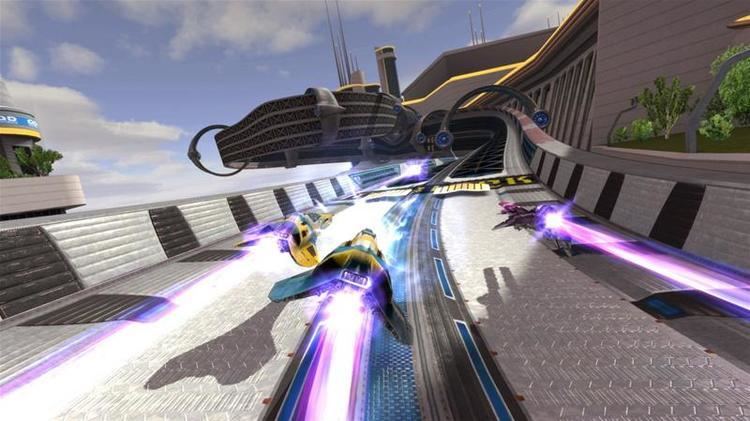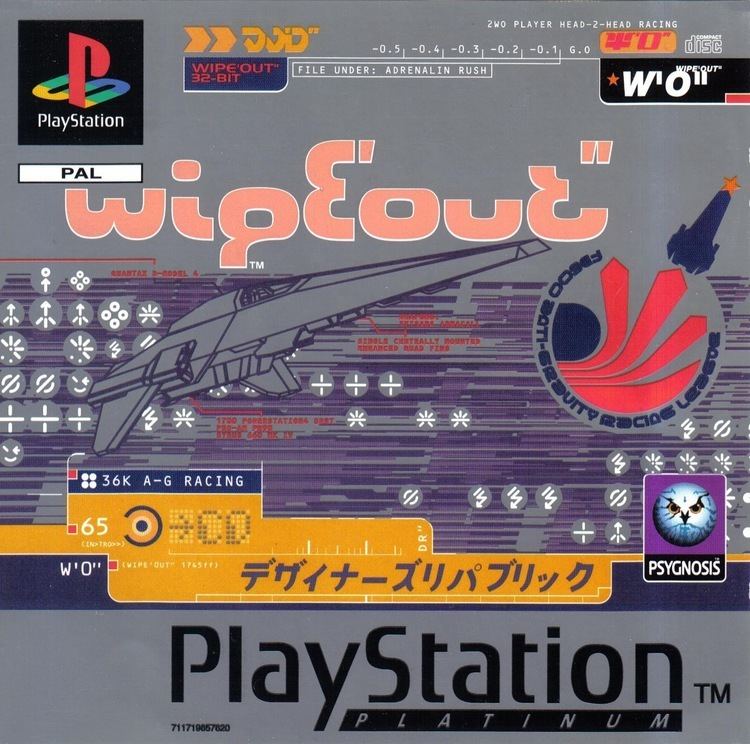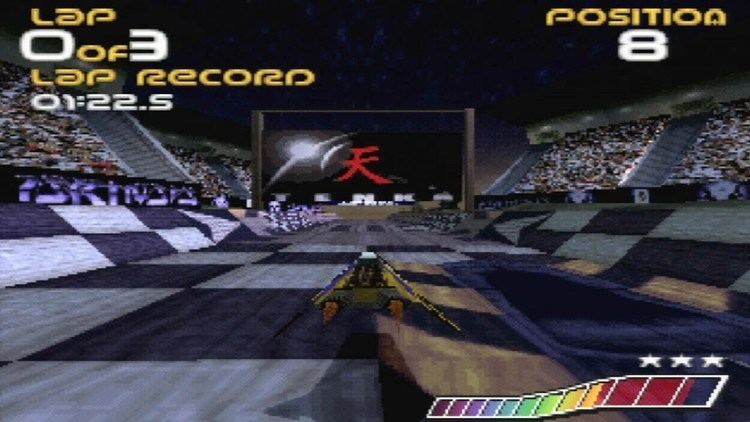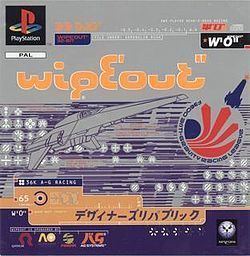Producer(s) Dominic Mallinson Series Wipeout | Director(s) John White Initial release date 29 September 1995 | |
 | ||
Programmer(s) Dave Rose, Rob Smith, Jason Denton, Stuart Sockett Artist(s) Keith Hopwood, The Designers Republic, Jim Bowers, Nicky Carus Westcott, Laura Grieve, Louise Smith, Darren Douglas, Pol Sigerson Writer(s) Nick Burcome, Damon Fairclough (manual) Similar Wipeout HD, Wipeout 3, Wipeout 2048, Wipeout 2097, Wipeout Pure | ||
Wipeout (stylised as wipE'out") is a futuristic racing video game developed and published by Psygnosis. It is the first game in the Wipeout series and is set in 2052. It was originally released in 1995 for PlayStation and PCs running MS-DOS, and in 1996 for Sega Saturn, being a launch title for the PlayStation in Europe and North America. It has since been re-released as a downloadable game for the PlayStation 3 and PlayStation Portable via the PlayStation Network in 2007.
Contents

Set in 2052, players compete in the F3600 anti-gravity racing league, piloting one of a selection of craft in races on several tracks around the world. Unique at the time, Wipeout was noted for its futuristic setting, weapons designed to both stall and destroy enemy opponents and its marketing campaign designed by Keith Hopwood and The Designers Republic. The game features music from CoLD SToRAGE, Leftfield, The Chemical Brothers and Orbital. The game was critically acclaimed on release; critics praised the game for its originality and its vast "unique techno soundtrack". However, it was criticised for its in-game physics. Wipeout managed to spawn several sequels to critical acclaim.

Gameplay

Wipeout is a racing game that is set in 2052, where players compete in the F3600 anti-gravity racing league. The game allows the player to pilot one of a selection of craft in races on several different tracks. There are four racing teams to choose from, and two ships for each team. Each ship has its distinct characteristics of acceleration, top speed, mass, and turning radius. By piloting their craft over power-up pads found on the tracks, the player can pick up various weapons and power-ups such as shields, turbo boosts, mines, shock waves, rockets, or missiles. The power-ups allow the player to either protect their craft or disrupt the competitors' craft.

There are seven race tracks in the game, six of them located in futuristic versions of countries including Canada, Germany, Greenland, United States, China and Japan. After all tracks have been completed on the highest difficulty, a hidden track set on Mars is unlocked. Multiplayer mode is only available in the PlayStation version, and features the option of having a competitive two player mode throughout the seven tracks, with the usual six remaining AI competitors.
Development and release
Wipeout was developed and published by Liverpudlian developer Psygnosis (later known as SCE Studio Liverpool), with production starting in the second half of 1994. According to Lee Carus, one of the artists, Wipeout took 14 months to develop, and the concept began as a conversation between Nick Burcombe and Jim Bowers at a pub in Oxton, Merseyside. Bowers then started on a concept film which was showed around Psygnosis' offices. It proved popular, and Wipeout was approved and production began. The marketing and artwork were designed by Keith Hopwood and The Designers Republic in Sheffield. Aimed at a fashionable, club-going, music-buying audience, Keith Hopwood and The Designers Republic created art for the packaging, in-game branding, and other promotional materials. An early beta version appeared in the teen cult film Hackers (1995), in which both protagonists were playing the game in a nightclub. Shortly after the film's release, Sony expressed interest Psygnosis on the basis of their "impressive work it had done with 3D graphics". In September 1995, Sony Computer Entertainment purchased Psygnosis and later renamed SCE Studio Liverpool in 2000.
The team was under pressure, as it consisted of around ten people, and they were on a tight schedule. Carus stated that the code had to be rewritten three quarters of the way through development, and that the team was confident that they could complete the game on time. The vehicle designs were based on Matrix Marauders, a 3D grid-based strategy game whose concept was developed by Bowers and released for the Amiga in 1994. Burcombe, the game's future designer, was inspired to create a racing game using the same types of 'anti-gravity' vehicles from his experience with Powerdrome and F-Zero. The name "Wipeout" was given to the game during a pub conversation, and was inspired by the instrumental song Wipe Out by The Surfaris. Designing the tracks proved to be difficult due to the lack of draw distance possible on the system. Players received completely random weapons, resembling Super Mario Kart in their capability to stall rather than destroy opponents. Burcombe said that Wipeout was influenced by Super Mario Kart more than any other game.
Wipeout gained a significant amount of controversy on its initial release. A marketing campaign created and launched by Keith Hopwood and The Designers Republic included an infamous promotional poster, featuring a bloodstained Radio 1 DJ Sara Cox, which was accused by some of depicting a drug overdose. Next Generation printed the ad with the blood erased; the magazine staff explained that not only had they been under pressure from newsstand retailers about violent imagery in games magazines, but they themselves felt the blood added nothing to the ad other than shock value. The poster branded Wipeout "a dangerous game", with Wipeout's designer Nick Burcome suggesting that the "E" in Wipeout stood for ecstasy.
Wipeout was first released alongside the PlayStation in Europe in September 1995. It was the PlayStation's best-selling launch title in Europe. In November 1995, it was released in the United States. The game went to number one in the all format charts, with over 1.5 million units of the franchise having been sold to date throughout Europe and North America. Wipeout was ported to the Sega Saturn in 1996, however because the company behind the PlayStation, Sony, owned the applicable rights to most of the PlayStation version's soundtrack, new music was recorded for the Saturn version by Psygnosis's in-house music team, CoLD SToRAGE.
Music
The game's electronica soundtrack was mostly composed by Welsh video game music composer Tim Wright under the alias CoLD SToRAGE. Music tracks were licensed from non-mainstream electronica acts to create an original soundtrack album titled Wipeout that was released to promote the game in 1996. This music album featured a selection which contrasted against the music included within the game, with CoLD SToRAGE being the most notable omission given his prevalence within both Wipeout and numerous successors. Additional songs featured in Wipeout are from Leftfield, The Chemical Brothers, and Orbital and were included in the PAL version of the PlayStation game, while the Saturn version included three songs by Rob Lord and Mark Bandola. Burcombe explained that the choice of genres was based on an experience he had with Super Mario Kart: he had just finished in first but had Age of Love playing instead of the game's soundtrack, and thought it fitted the moment. Persuading record companies to get involved with Wipeout proved difficult as they did not understand what the development team wanted.
Reception
Upon release, the game was critically acclaimed. IGN staff praised the game for its originality and unique techno soundtrack, but criticised the difficulty with manoeuvring the vehicles and also the difficulty of the game itself, stating that "there aren't nearly enough competitors" and that the player would have "[pulled] ahead of the other racers with no problem". Edge cited that it was hard to criticise "such a beautifully realised and well-produced game which [exploited] the PlayStation’s power so well", but did show similar concerns over the game's longevity regarding its "reliance on track-based power-ups" that would "limit Wipeout’s lifespan" in comparison to Super Mario Kart. GamePro gave the PlayStation version a rave review, predicting that "Wipeout's taut action and grueling courses will lure many diehard racing fans to this new system." They particularly praised the challenging gameplay and precision controls. They said the fact that multiplayer is only through the PlayStation Link Cable is the game's one major flaw, since the PlayStation still had a low installed base at this point and thus this would not be an option for most players. A reviewer for Next Generation applauded the stylish and detailed visuals, the "heart-pounding soundtrack", and particularly the exhilarating feel of the racing. He commented that the controls have a potentially frustrating learning curve but are worth mastering, and deemed the game "A new high-water mark". Maximum opined that of all the games in the PlayStation's European launch lineup, "not one title can match up to the awesome nature of Psygnosis' WipeOut. It's an amazing spectacle to behold, it sounds absolutely fantastic and it's the best playing racing game yet beheld on a next generation super console." Making particular note of the lack of pop-up, the coherent style and concept, the soundtrack, the unlockable Rapier mode, and the PAL optimization, they gave it their "Maximum Game of the Month" award.
The later Saturn version also received generally positive reviews, though most critics agreed that it was not as good as the PlayStation version. In Sega Saturn Magazine, Rad Automatic praised the large number of tracks and the distinctive flavour of each one, and remarked that the gameplay is very easy to get into but provides more than enough challenge. He criticised it as not being as good as the PlayStation version, though he noted that none of the shortcomings impact the gameplay. The four reviewers from Electronic Gaming Monthly similarly praised the number and variety of tracks along with the strong challenge the game presented, and were much more approving of the graphics than Sega Saturn Magazine, describing them as "vibrant" and "gorgeous". Both Air Hendrix of GamePro and a reviewer for Maximum argued that the Saturn version is noticeably not as polished as the PlayStation version but still excellent in absolute terms, making it a pointless purchase for PlayStation owners but recommended for Saturn-only players.
Legacy
The game's initial success led to Psygnosis developing several sequels which would later become part of the Wipeout franchise. A direct sequel, Wipeout 2097, was released for the PlayStation and Sega Saturn in 1996, which was met with positive reviews, especially aimed towards the vastly improved game engine and new physics the game offered. A Nintendo 64 spin-off, Wipeout 64, was released in 1998 and was met with considerable praise from critics, but was noted to be too similar to the original Wipeout. After the release of Wipeout in 1995, the awareness of the underground techno community in England was significantly boosted, with critics praising the vast "unique techno soundtrack" the game offered.
Wipeout has been described as being synonymous with Sony's debut gaming hardware and as an early showcase for 3D graphics in console gaming. It has since been re-released as a downloadable game for the PlayStation 3 and PlayStation Portable via the PlayStation Network in 2007.
